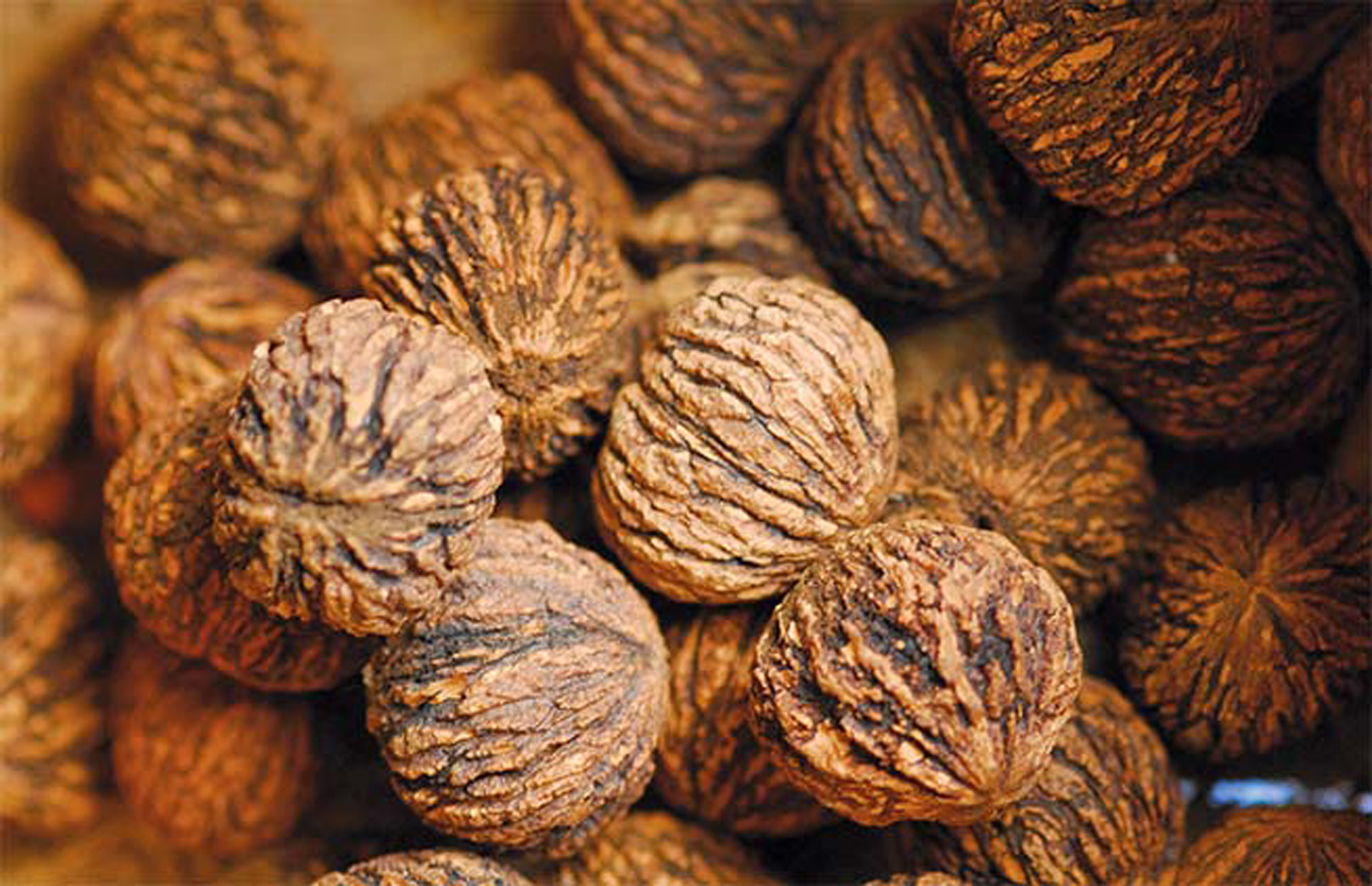Black Walnuts: Nutritious Native Nut Worth Cracking
Wild Harvest
It’s hard to miss black walnut season. The tennis-ball-sized vermilion fruits hang like ornaments from the tree’s branches and can easily be spotted in the wild along roads and tree lines.
“Black walnuts primarily grow in the central and northeast United States and are widely found throughout New Jersey,” says Jared Rosenbaum of Wild Ridge Plants in Pohatcong. “They thrive in disturbed landscapes that are associated with old river systems and creeks because they love deep rich soils.”
Rosenbaum explains that the tree is prolific for a reason. “They produce a chemical called juglone, which inhibits other plants from growing near it,” he says. “When you encounter a black walnut tree, you’ll see there is not much growing beneath it.”
Though these nuts are called walnuts, they are quite different from the walnuts most Americans are used to. Their flavor is distinct and, to some, an acquired taste.
“If you’re expecting the taste of an English walnut, you may be surprised,” says Thomas Molnar, associate professor of plant biology and pathology at Rutgers University in New Brunswick. “Though the texture is similar, these have more tannins, imparting a strong, wine-like, fruity flavor.”
If you’ve ever spotted black walnuts in the grocery store, you may have noticed they are quite pricey: A pound can cost 30 to 50 percent more than English walnuts, depending on quality. Molnar explains that this is because they are difficult to crack: “The shell is very thick, with a lot of partitions inside that go right into the kernel.”
Though it’s an arduous task, there is hope for the impatient.
“Black walnut cultivars have been created from trees found in the wild, with desirable traits like being easier to crack and having a higher kernel percentage,” says Molnar, adding that one of his favorites is a cultivar called Emma-K, which has a good shell and a high yield.
“Black walnut season typically runs from late August through mid-October,” says Eddie Starnater, who owns Practical Primitive in Great Meadows along with his wife Julie Martin. “It varies every year. The trees go through cycles and some years are more abundant than others,” he says.
Before embarking on your first harvest, Starnater strongly suggests wearing a pair of heavy-duty rubber kitchen gloves. “You have to be very careful when handling the hulls,” he says. “They produce a yellow-whitish liquid that will stain your hands and is slightly caustic as well.” The best way to harvest black walnuts is to gather them immediately once they’ve fallen to the ground.
“Collect them when husks are still green and you can make a little indent into the husk—this lets you know they are ripe,” says Starnater. “Don’t wait until they turn brown and get soft. At this point, a lot of tannins from the hull will have leeched into the nutmeats, making them bitter.”
After you’ve collected your nuts, the next step is removing the hull. “Stomp on the nut and slide your foot over it to separate it from the nut,” says Martin. “Afterward, rinse the nuts in a bucket, using a sprayer hose to remove any remaining pulp.”
From there, the nuts must be dried for a few weeks in a well ventilated place, away from squirrels. You can tell the nuts are ready to crack when you can hear them rattling inside their shells. Next comes the hardest part—literally.
“Some folks drive over them with their car or use a vise, but a common way to crack them is to just use a hammer, covering the nut with a kitchen towel so pieces of the shell don’t go flying,” Martin says. Since black walnuts are strong in flavor, a little goes a long way. When it comes to nutrition, however, they go quite far.
“Nutritionally, black walnuts are similar to English walnuts, but they are higher in protein, potassium, and phosphorus,” says Beverly Manganelli, director of the Center for Nutrition and Diabetes Management at Hunterdon Healthcare in Flemington. “Phosphorus helps repair tissues and cells, builds strong bones and teeth and filters waste from the kidneys.”
Manganelli also notes that black walnuts are rich in magnesium, copper, vitamin E and an important B vitamin called biotin. “Biotin helps the body convert carbohydrates into glucose to produce energy. It is also needed for healthy skin, hair and nails. If you’re deficient in biotin, symptoms can include hair loss, dry, scaly skin and cracking at the corners of the mouth,” she says.
Black walnuts are also high in omega-3 fatty acids, which boast a multitude of cardiovascular benefits. “Omega-threes help improve cardiovascular function, reduce the risk of heart disease, improve blood pressure and lower cholesterol,” Manganelli says. “Cardiovascular disease is a big concern for folks with type II diabetes, so adding walnuts into their diet is a good idea.”
If you’re trying black walnuts for first time, obey the foragers’ rule: Don’t take more than you’re going to use. Harvest a small amount to see if you like them. If the taste suits you, then happy cracking— what’s a reward without a little struggle?







